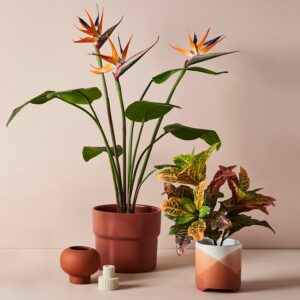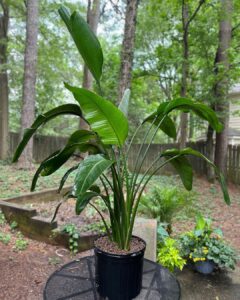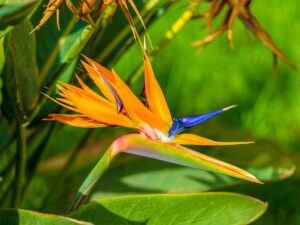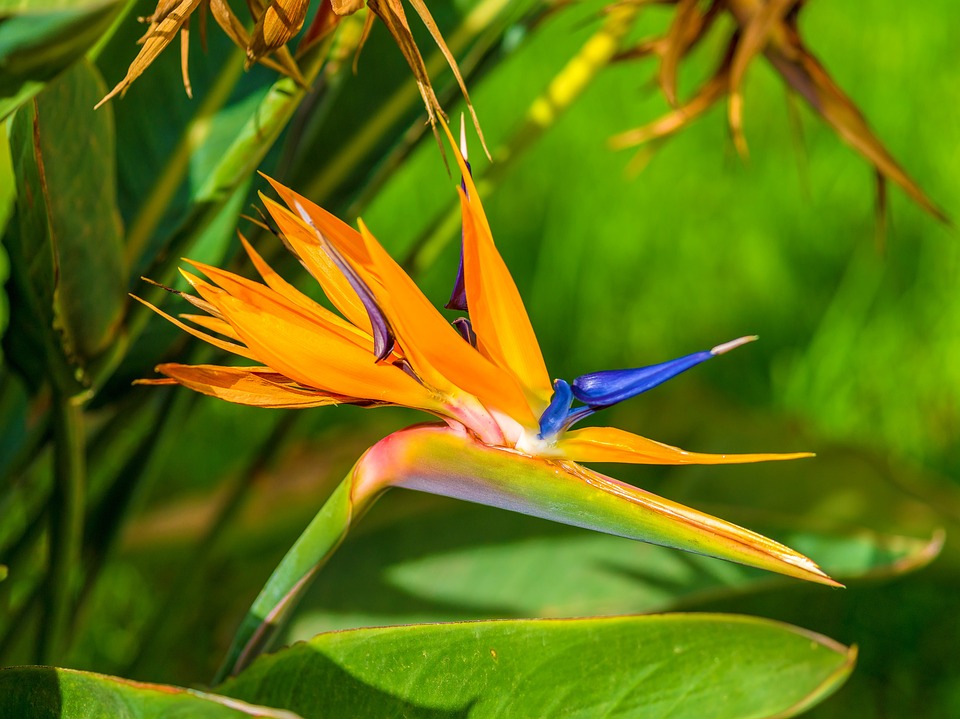Check out the ultimate Common Bird of Paradise Problems and Solutions Guide and master the art of nurturing this exotic plant.
The beautiful Bird of Paradise plant is popular for its lush foliage and stunning blooms. However, it can face problems that affect its appearance and health. Don’t worry! By taking the right steps, you can bring back its rich colors and restore its overall vitality. Follow this Common Bird of Paradise Problems and Solutions Guide to witness positive changes in your plant!
Common Bird of Paradise Problems and Solutions Guide

1. Yellowing Leaves
Low humidity or under-watering can cause yellowing leaves in plants, indicating the need for action. The lack of nutrients, including magnesium, iron, zinc, and nitrogen, can contribute to the yellowing of leaves.
Insufficient sunlight also leads to yellowing leaves. It is important to provide the bird of paradise plant with a minimum of 6 hours of direct sunlight to prevent this issue.
Solution
- To promote healthy growth in your bird of paradise plant, provide a nutrient boost to the soil using organic fertilizers such as blood meal, manure, and sludge.
- Additionally, supplementing with inorganic NPK 1:1:1 fertilizer can be beneficial.
- Iron supplements should be used to correct iron deficiency.
- Ensure proper watering techniques to allow the fertilizer to seep into the soil effectively.
- Moreover, relocate the plant to a suitable spot where it can receive adequate sunlight.
2. Leaflessness
The bird of paradise plant typically retains its attractive leaves, but they may occasionally droop and collapse due to various reasons.
Leaf shedding is responsible for causing leaflessness and indicates stunted growth in the bird of paradise plant.
Adequate water is crucial for the production of flowers and leaves. Insufficient or excessive watering can result in leaf shedding in the bird of paradise plant. To sustain the plant during prolonged drought periods, it is necessary to supplement water actively.
Other factors of leaflessness are:
- Shock from transplanting
- Pests and diseases
- Light deprivation
- Low humidity
- Old leaves
Solution
To address this Bird of Paradise problem, it is essential to adhere to appropriate maintenance methods actively.
- Ensure proper watering with adequate drainage to prevent both overwatering and underwatering.
- Additionally, make sure the plant receives all the necessary nutrients and sufficient light to promote leaf growth.
3. Brown Margins or Tips
The browning of leaves is a frequent issue that indicates various problems. Brown edges are primarily caused by water containing chlorine or other salts. In certain regions, chlorinated or fluoride-treated tap water is the culprit behind the brown edges in bird of paradise plants.
Other factors contributing to brown tips include underwatering, low humidity, fungal infection, and inadequate light.
The leaves exhibit browning along the edges before becoming crunchy.
Solution
- To accommodate the sensitivity of the bird of paradise plant, actively substitute tap water with pure, filtered water.
- Additionally, rectify humidity issues by regularly misting the plant or utilizing a humidifier.
- These active measures will help maintain optimal conditions for the plant’s well-being.
4. Top Heaviness
As the Bird of Paradise grows to its maximum height of approximately 60-72 inches and develops multiple stems, it can appear top-heavy and lopsided. This occurs because the stems struggle to support the weight of the plant.
The leaning of the Bird of Paradise can be attributed to root rot, insufficient pruning, and uneven light exposure. Taking active measures, such as addressing root rot, performing regular pruning, and ensuring even exposure to light, will help maintain a balanced and upright growth for the plant.
Solution
- To correct the leaning caused by uneven light distribution, actively rotate the plant.
- Use sharp shears, loppers, or pruning saws to prune your plant. Begin by pruning the old leaves and stems at the beginning of spring.
5. Curling Leaves
Curling of strelitzia leaves occurs as a response to moisture loss, with the leaves curling inwards to minimize water loss through the leaf surface. Leaf curling can be caused by underwatering, low humidity, heat stress, cold drafts, transplanting, pests, and diseases.
Leaf curling can lead to withering and wilting of the leaves. Taking active measures to address the underlying causes of leaf curling is essential to prevent further damage and maintain the health of the plant.
Solution
- To compensate for the water lost through transpiration, actively water the bird of paradise plant frequently.
- Address low humidity by actively misting the plant or using a humidifier to prevent the drooping and death of leaves.
Read about Hydrophobic Soil: Causes and How to Fix It
6. Root Rot
Excessive watering primarily causes root rot in Bird of Paradise plants. When the soil becomes soggy, it hampers the roots’ oxygen absorption, leading to weakened roots and reduced uptake of water and nutrients. This creates a vulnerable environment for fungal and bacterial infestations, which result in curled leaves, wilting, and the potential death of the plant. To prevent these detrimental effects, it is crucial to avoid overwatering actively.
Solution
- Mushy and brown or black roots indicate root rot, which should be addressed by cutting the affected roots with sharp pruning shears.
- It is also necessary to inspect the potting mix and replace it, if needed, using a free-draining mixture.
- Improving drainage and aeration can be achieved by adding gravel or stones.
- In treating root rot, the active use of home remedies like chamomile, cinnamon, and charcoal has shown helpful results.
7. Legginess or Growing Too Tall

The bird of paradise plant is known for its rapid indoor growth, reaching heights of 5-6 feet and widths of 3-5 feet during its growth phase. However, if its stems are weak and thin, it can become leggy, with foliage outpacing the plant’s support system. This legginess is often caused by improper lighting and high nitrogen soils, leading to excessive height.
Solution
- To address legginess in plants, decrease the use of nitrogen-based fertilizers and instead focus on increasing potassium levels, which facilitate root development and overall plant health.
- Additionally, it is crucial to ensure adequate moisture, appropriate lighting, balanced nutrition, and proper drainage for optimal plant growth.
8. Leaf Splitting

Leaf splitting is a common phenomenon in bird of paradise plants, where the leaves may split along the veins or become unraveled. This can happen due to factors such as strong winds, low humidity, watering problems, infections, or human and animal activity. While leaf splitting is expected, there are preventive measures and remedies available to address this issue.
Solution
To address leaf splitting in bird of paradise plants, remove the affected leaves and relocate the plant to a location with less exposure to direct sunlight or strong winds.
9. Fail to Flower

Insufficient light and improper repotting are common factors that can hinder the blooming of bird of paradise plants, requiring careful attention to ensure optimal growth and flowering.
Solution
- The blooming process of the bird of paradise plant requires patience, particularly when grown from a young age.
- It typically takes approximately five years for a young plant to produce its first flowers.
- For those wanting quick blooming, buy more mature bird of paradise plants.
- However, they come at a higher cost compared to younger ones.
- Investing in a mature plant can expedite the flowering process and provide a more immediate display of its stunning beauty.
10. Pests and Diseases
Bird of Paradise plants are generally resistant to pests, but occasional issues with bugs can arise. Mealybugs and scale are the most common pests that affect Bird of Paradise plants. Scale manifests as small, rigid brown spots on the stems and undersides of the leaves, while mealybugs appear as fuzzy white patches on the leaves.
Additionally, caterpillars, snails, and grasshoppers may attack the plants, leaving visible bite marks on the leaves. Leaf borers can be observed targeting flower bracts in late summer. Aphids, which can be spotted without magnification, can also pose a problem. One telltale sign of aphids, apart from their visible presence, is the presence of ants on the plants as they collect the sweet honeydew secreted by these pests.
Solution
- Caterpillars and snails, common pests of large Bird of Paradise plants, can be manually removed by hand.
- Aphids can be eliminated by spraying a steady stream of water onto the plant.
- Scale and mealybugs can be eradicated by applying rubbing alcohol.
- Alternatively, these pests can be treated using insecticides or horticultural oil.
- Systemic insecticides, which are absorbed by the roots and distributed throughout the entire plant, are particularly effective in controlling these pests.



